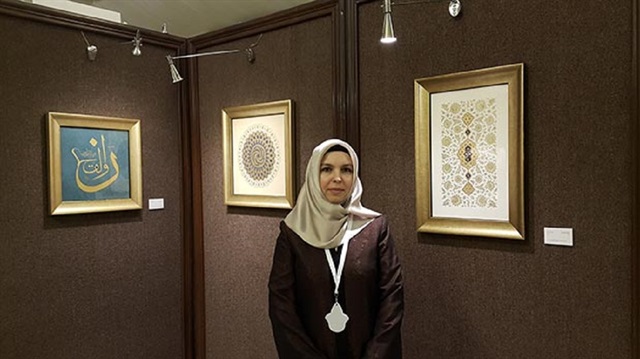
The art of tezhip, meaning “goldening” in Arabic, is an attractive manuscript art, also referred to as Ottoman or Turkish illumination.
Tezhip includes non-figurative painted or drawn art in books. The art form encompasses a spiritual dimension as it is deeply connected to the Qur’an and other Islamic texts it embellishes.
Tezhip master and scholar Professor Dr. Çiçek Derman once said, “If the aim of the hattat (calligrapher) is to write the Holy Qur’an in his best handwriting, the aim of the tezhip artist is to illuminate it to express what is in their heart.”

A former student of Derman’s, Fatma Özçay believes once you get a taste of the art form, everything else excluding family, comes second.
Özçay was encouraged to study tezhip by her two elder brothers, Mehmed and Osman Özçay, both master calligraphers.
National and international recognition in the world of traditional Islamic arts has followed Özçay, and she is recognized for her work’s refinement, precision and classical inspiration.

Özçay often designs and executes the tezhip work of contemporary calligraphers, including her two older brothers.
Additionally, she presents her tezhip work at exhibits, as Özçay is a renowned artist who has developed a unique adaptation of tezhip that combines modern notions of art.
Many of her works are inspired by classical Ottoman styles, while others showcase a modern flair that don’t play by the classical rules of the art.
Özçay once opposed such innovations, but now says it is possible to construct such novelties without undermining the art’s classical laws.

“Dreams” is a water color and pure gold piece that demonstrates such innovations.
Referring to “Dreams,” Özçay said: “While I was drawing the free design, I was thinking about space: that everything started from a point that is still expanding and turning. This reminded me that the point is connected to God, like his seal.”
Özçay asserts that the pillar of the tezhip art form is meaning embedded into the spiritual dimension.
“I believe that if a Muslim artist works expecting the acceptance of God, his or her work will acquire meaning and spirit. So I always work with the hope of reaching beauty; like the moth turning around the light to reach it at any cost, I will continue until the last breath, because real beauty is just in the presence of God,” she said.
Özçay goes on to add that working on tezhip is a method in which one becomes more aware of and connected to the presence of God, and concedes that it is a manner of self-knowledge.
“My real world is art, which shows my soul and feelings. Sometimes, I imagine the flowers in paradise and try to design them, which makes me as happy as if I had actually seen them. İf you want to know me, you just look at my artwork so that you see my feelings, dreams, belief and soul,” she said.
Özçay is now a teacher at the Classical Turkish Arts Foundation in Istanbul. Both a tezhip teacher and artist, Özçay is a key figure in keeping the tradition of tezhip alive.














